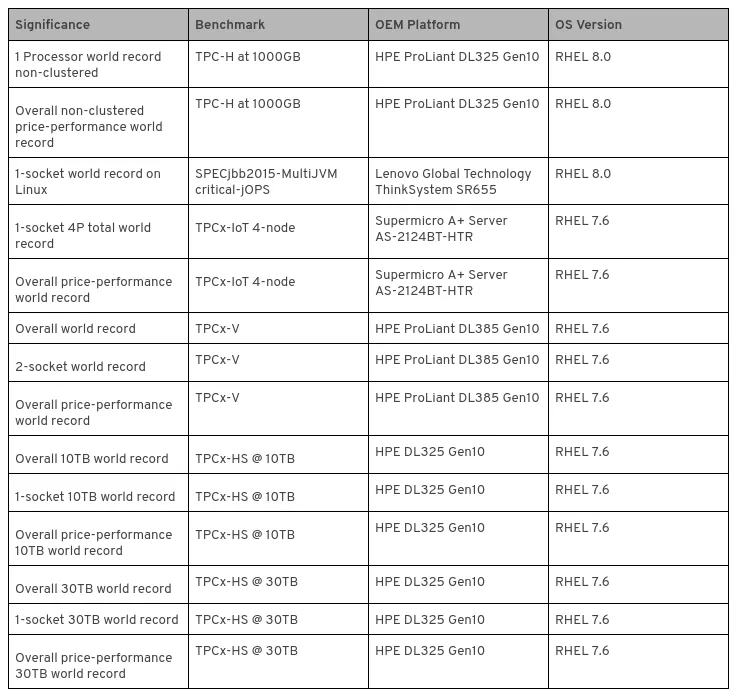As x86_64 hardware sees improvements in the area of CPU die size reduction, Red Hat has continued to work with our partners to better enable world class performance. Recently, AMD released its ROME line of processors, known as the AMD Epyc 7002 Series. With a die size of 7nm, AMD has achieved several new performance world records and many of these results have been with workloads running on Red Hat Enterprise Linux (RHEL) 7 and RHEL 8.
Leaning on our long history of collaboration, Red Hat and AMD have worked together to deliver enhanced performance to enterprise data centers and beyond. Red Hat’s development and performance engineering teams have been working on hardware enablement and validation of these ROME processors for more than a year, resulting in several benchmark publications using RHELx.
Red Hat engineering uses prototype hardware from partners to integrate partner specific changes that are pushed upstream into various supported RHEL.x versions. The Red Hat performance engineering team runs a variety of CPU, Memory, Disk and Network IO that ensure proper operation which enable peak performance. These benchmarks cover SQL Server (TPC-H), Java performance (SPECjbb2015), IoT gateways (TPCx-IOT), busy database workloads (TPCx-V) and big data systems (TPCx-HS).
Red Hat is working to enable world class enterprise performance on new hardware across supported architectures. Today, we’re pleased to share the new world records set by AMD partners with both RHEL 7, as well as the first set of results using RHEL 8.
Results1

Source: https://www.amd.com/en/processors/epyc-world-records
These benchmarks cover a broad spectrum of workloads. We believe they provide solid evidence that RHEL excels at handling scalable workloads and thrives in changing environments. We know this is important as enterprise customers place increasing demands on their infrastructure.
The ongoing support and collaboration with AMD and the ecosystem of ISV and OEM partners does not stop with benchmarks. It goes beyond performance to new chip and server features to make RHEL a natural choice for advanced projects, leading-edge implementations and other emerging technology efforts that our partners and customers may be engaging in. We are seeing OEM/ISV's use RHEL 7 and now RHEL 8 to run “extreme” workload benchmarks, and expect to see this role expand as more applications are certified on RHEL 8.
The confidence placed in Red Hat by our customers and partners like AMD is a motivator for expanding capabilities and delivering innovative features in the future versions of the Linux OS. Our continued goal is to be the trusted OS of choice for partners and customers alike, regardless of scale, architecture or complexity of workloads.
À propos de l'auteur
Plus de résultats similaires
Behind the scenes of RHEL 10, part 3
Alliander modernises its electricity grid with Red Hat for long-term reliability in balance with rapid innovation
The Overlooked Operating System | Compiler: Stack/Unstuck
Linux, Shadowman, And Open Source Spirit | Compiler
Parcourir par canal
Automatisation
Les dernières nouveautés en matière d'automatisation informatique pour les technologies, les équipes et les environnements
Intelligence artificielle
Actualité sur les plateformes qui permettent aux clients d'exécuter des charges de travail d'IA sur tout type d'environnement
Cloud hybride ouvert
Découvrez comment créer un avenir flexible grâce au cloud hybride
Sécurité
Les dernières actualités sur la façon dont nous réduisons les risques dans tous les environnements et technologies
Edge computing
Actualité sur les plateformes qui simplifient les opérations en périphérie
Infrastructure
Les dernières nouveautés sur la plateforme Linux d'entreprise leader au monde
Applications
À l’intérieur de nos solutions aux défis d’application les plus difficiles
Virtualisation
L'avenir de la virtualisation d'entreprise pour vos charges de travail sur site ou sur le cloud
